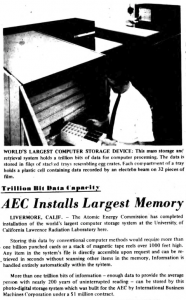Nov. 1, 1967: Atomic Energy Commission’s 125 GB storage system breaks world record
In 1967, a $1 million dollar contract produced a record-breaking 125 GB computer storage system. Today, the same storage can fit in a USB flash drive and costs less than $15.

In 2020, digital storage is more affordable and accessible than ever. Consumers can purchase laptops with 8 terabytes (TB) of storage and buy an inch-long 125 gigabyte (GB) flash drive for less than $15 on Amazon. Though now commonplace, 125 GB was enough to make headlines back in 1967. The $1 million IBM 1360 Photo-Digital Storage System (PDSS) appeared on the front page of Computerworld magazine for being the world’s first storage system capable of storing “1 trillion bits” (125 GB) of data. In 2011, an IBM computer storage system made headlines again, but this time for a record-breaking capacity of 120 petabytes – nearly 1 million times larger than the IBM 1360.
The Atomic Energy Commission (AEC) purchased the IBM 1360 PDSS for installation at the Lawrence Livermore National Laboratory (LLNL). The AEC was a federal agency established after World War II to direct the development of atomic technology. Due to concerns about insufficient protective regulations, the AEC was dissolved in 1974. Prior to dissolving, the AEC established and oversaw many national laboratories, including the LLNL. From its inception, the LLNL has been a leader in scientific computing, successively acquiring the world’s most powerful computers to study challenging scientific problems. In 1967, the AEC used their record-breaking storage system to manage data used in their research simulations.
The IBM 1360 PDSS stored data on small photographic film cards called chips. Sets of 32 chips were stored in thousands of plastic boxes called cells, which were stored on trays inside three large filing units. Cells were “blown” between the filing units and reading station through a pneumatic shaft system. Data was “painted” onto chips by an electron beam. The beam created dark marks on the film, while unmarked areas formed a light mark. This facilitated a binary encoding system where a dark-light pattern represented a 0 and a light-dark pattern represented a 1.
The installation at the LLNL was the first of just five “Cypress systems” ever installed by IBM, all contracted by the federal government. By the time the installations were completed, IBM had invented and began promoting more advanced storage systems. The Cypress systems were valued by its few users, with three of the systems used into the late 1970s.
–By Kathleen Esfahany